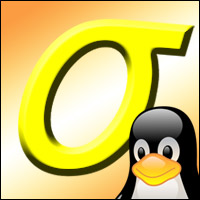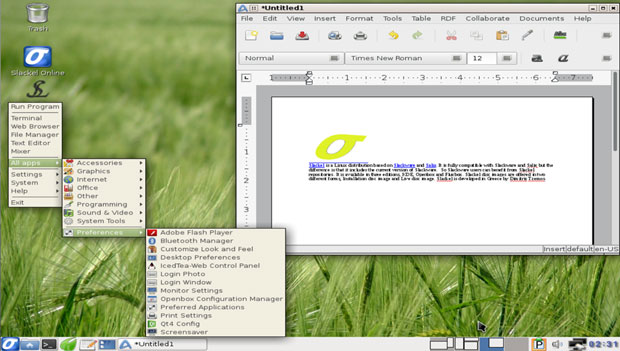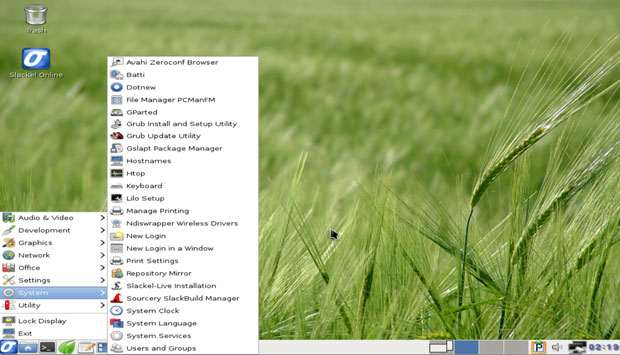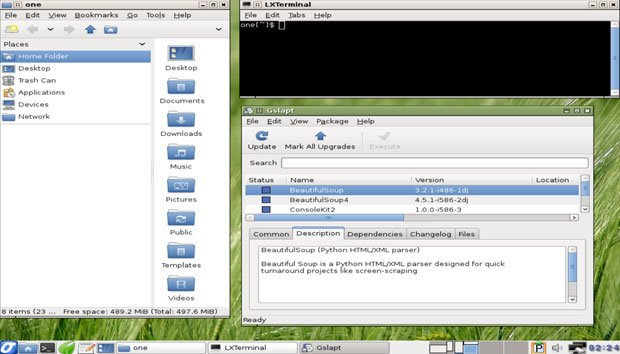
![]()
Slackel’s Openbox edition is a lightweight operating system that offers reliable performance once you get the box open. It is not an ideal OS for every user, though.
Slackel 6.0.8 Openbox, the latest version of the Greece-based project’s lightweight distribution, was released by developer Dimitris Tzemos last fall.
Slackel is a Linux distro that offers several benefits for users who step away from the typical mainstream Debian-based Linux distros. Based on both Slackware and Salix, it offers a few advantages not usually found with the Slackware Linux lineup.
For example, Slackel is fully compatible with both Slackware and Salix software packages. The main difference is it includes the current version of Slackware and the latest version of KDE in the repository.
That gives Slackel a better reach for adding software. Slackware-based distros typically have far smaller software repositories than Debian-based distros and others. Think in terms of a few thousand packages compared to 35,000. Finding Linux packages that will run in Slackel is less of a challenge — but you will have slimmer pickings.
Slackel provides some of the best Slackware-based system tools, which is a big plus since Slackel also has all the Salix system tools present. It makes system administration easy and straightforward. The Salix codecs installer application installs patent-encumbered codecs quickly and easily.

Getting It
Normally, a live session disc image combines the ability to run the Linux OS from a bootable DVD with direct access to the hard drive installation. All you have to do is click a desktop install icon without leaving the “try-it-out” mode.
Not so with Slackel Linux. The Slackel disc images come in two separate forms: installation and live. Both are available in both 32-bit and 64-bit versions.
You have to pay attention to the download links. Slackel’s standard release uses the KDE environment. The Slackel line also offers the Fluxbox desktop. Be sure you grab the Openbox edition — twice. You will need the live session and the install-only images.
The 64-bit ISO images support booting on UEFI systems. The 32-bit ISO images support both i686 PAE SMP and i486, non-PAE capable systems.
Slackel is a bit less cooperative in putting the ISO onto a USB thumb drive. I usually run that procedure as a routine matter with other distros. If you want to transfer the ISO to a USB drive, check out the specific instructions here.
You can use the dd command to write the iso to a USB stick. However, dd is not a perfect solution with Slackel. It works — but some features like persistence will not be available.
I found the Slackel installation ISOs to be particularly finicky in configuring on UEFI systems. This is especially the case if you insist on setting up a dual boot around a Microsoft Windows partition. Read the directions very carefully.
Big Frustration Alert: Do not use eLilo as your bootloader. If you do, you will not be able to boot Windows partitions.
What’s Inside
Slackel 6.0.8 Openbox includes the Linux kernel 4.4.29 and latest updates from Slackware’s ‘Current’ tree. The live session ISO images contain full multimedia support.
You do not have to install multimedia codecs while on live environment. However, remember to install multimedia codecs after you put SlackelOpenbox on your hard drive from the installation ISO.
Slackel 6.0.8 Openbox includes the Midori 0.5.11 Web browser. This distro does not provide automated installers for other Web browsers.
If you want to add a standard preference such as Firefox or Chromium, you will need to launch the gslapt Package Manager. gslapt is a GTK+ front-end to slapt-get — an APT-like package tool for Slackware.
Other standard software packages in the Openbox edition include Claws-Mail 3.13.2, Transmission 2.92, PCManFM 1.2.4 and Pidgin 2.11.
Smplayer is the default movie player. Exaile 3.4.5 is the default application for managing music collections. Other media tools include Asunder 2.7 Cd ripper and Bracero 3.12.0 for writing CD/DVDs. Graphics software includes Viewnior 1.6, GIMP 2.8.18 and mtpaint 3.40. Scrot is the snapshot utility.
Openbox Look and Feel
The standard panel bar sits at the bottom of the screen. The left side of the panel has a very easy-to-use, uncluttered menu. A few icons sit on the left. The expected notifications are on the right end of the panel. Toward right center is a preconfigured work space switcher with four locations ready to use.

Openbox is similar to the Xfce desktop, but it has fewer configuration options. Like Xfce, you can right-click anywhere on the desktop to get a fully populated menu for system tools and applications. And like Xfce, you can not place icons on the desktop or the panel bar.
The panel bar is devoid of any extra features, such as applets. Openbox is very simple with some user tweaks built in, but power users will be less enchanted with its almost one-size-fits-all design.
Software Supplies
I was disappointed by the absence of some key software that I find bundled on other Linux distributions offering lightweight desktop options, such as Openbox. Some of them are available via other Slackel or Salix repositories, but having to track stuff down is inconvenient.
For example, Abiword 3.0.1 office application and Gnumeric-1.12.27 are included. Both applications are extremely lightweight and feature-deprived. You can add Libreoffice 5.2.3 from the Slackel repositories through gslapt.
Much to my pleasure, Slackel comes with the Geany IDE text editor installed. It also bundles the Leafpad text editor. Geany is one of my core applications.
If you install Slackel on just one computer, you’ll have to suffer through a one-time inconvenience. However, if you maintain multiple computers running the same set of applications for work projects, for instance, getting your working tools up to speed will become a much larger annoyance.
That is not the fault of Slackel itself — it is a characteristic of the Slackware Linux line. Slackware distros typically force you to find and install the software on your own.
Slackel Primer
The Slackel distro is a slice of the Slackware and Salix Linux ecosystems. It is just a better Slackware derivative.
Slackware originated in 1992. By comparison, well known and well used distros such as Ubuntu, Fedora and Linux Mint were introduced in the mid-2000s.
Salix is a GNU/Linux distribution based on Slackware. It is not a clone, however. It is built on the concept of being stable, fast and easy to use. Salix is fully backward-compatible with Slackware. One of the guiding priciples of Salix Linux is economy. It provides one application per task on the installation ISO.
Slackware is among the oldest actively maintained Linux distros. It tends to adhere to its less modern Linux underpinnings in terms of user-friendliness. The Slackware project started as a way to install a Linux system that already included some core packages like the kernel and an X window system.
In its long run, Slackware has updated but not improved much. It is still not easy to set up and use compared to more modern Linux distro replacements. If nothing else, Slackel tries to modernize that heritage just a bit.
Bottom Line
Slackel is not a good choice for new users looking to make a fast move into a Linux OS. Still, this distro has some benefits.
If you like to learn how things work, Slackel gets you closer to understanding the pure Linux environment. Plus, you have a system made your way because you decide what gets installed.
If you give Slackel Linux a test run, jot down these user credentials. Otherwise, you will soon be dead in the water.
The root password for the live CD is “live” (no quotation marks). The standard user login is “one” with password: “one”)
For installation and for all work required administration privileges, the super user “one” with password “one” is used.
Slackel Linux is hardware-friendly. Its minimum system requirements are Pentium 2 or equivalent, 256 MB of RAM and a 1.5 GB HDD.
Want to Suggest a Review?
Is there a Linux software application or distro you’d like to suggest for review? Something you love or would like to get to know?
Please email your ideas to me, and I’ll consider them for a future Linux Picks and Pans column.
And use the Reader Comments feature below to provide your input!























































